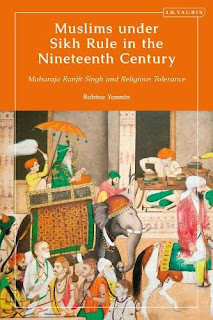Muslims under Sikh Rule in the Nineteenth Century: Maharaja Ranjit Singh and Religious Tolerance
| Though the history of Sikh-Muslim relations is fraught with conflict, this book examines how the policies of Sikh rulers attempted to avoid religious bigotry and prejudice at a time when Muslims were treated as third-class citizens. Focusing on the socio-economic, political and religious condition of Muslims under Sikh rule in the Punjab during the 19th century, this book demonstrates that Maharaja Ranjit Singh and his successors took a secular approach towards their subjects. Using various archival sources, including the Fakir Khana Family archives and the Punjab Archives, the author argues citizens had freedom to practice their religion, with equal access to employment, education and justice. | |||
Table of contents : Cover Halftitle page Title page Copyright page CONTENTS ACKNOWLEDGEMENTS INTRODUCTION Chapter 1 SIKH-MUSLIM RELATIONS: A HISTORICAL PERSPECTIVE Sikh–Muslim Relations – Common Grounds for Alliance Genesis of Sikhism – Sociopolitical Context A Brief Introduction of Sikh Gurus Relationship between Mughal Emperors and Sikh Gurus – Revisited Sikh–Muslim Relations – Later Developments (1708–99) Conclusion Chapter 2 CONQUESTS OF MAHARAJA RANJIT SINGH: TREATMENT OF THE FALLEN MUSLIM RULERS AND POPULATION Early Life Conquests of Maharaja Ranjit Singh Conquest of Muslim States: Lahore Kasur Multan Jhang Peshawar, Attock, Hazara, Dera Ghazi Khan, Dera Ismail Khan, Mankera and other areas Tehrik-e-Mujahidin Kashmir Conquest of Sikh States Conquests of Hindu States Story of the Famous Koh-e-Noor Diamond Conclusion Chapter 3 STATE POLICIES TOWARDS MUSLIMS: REALITY OR FAÇADE Socio-religious Demography of the Punjab Religious Policy Buildings – Shrines and Mosques Muslim Historic and Cultural Centres Akalis Economic Condition, Policies and Opportunities Case of Kashmir Economy of Multan Economic Potential of Other Parts of the Punjab Land Revenue, Agriculture, and Farming Policies and Prospects Educational Policy Justice System Conclusion Chapter 4 SARKAR-E-KHALSA: STATUS AND ROLE OF HINDU, MUSLIM AND EUROPEAN COURTIERS Darbar of Maharaja Ranjit Singh Composition of the Darbar: Courtiers Ministers and Executives General Administration Hindu Courtiers and Officials Diwan Mohkam Chand Diwan Moti Ram Diwan Kirpa Ram Misr Diwan Chand Diwan Dina Nath Misr Beli Ram European Officers Muslim Courtiers and Officials Fakir Brothers Conclusion Chapter 5 SIKH-MUSLIM RELATIONS IN THE POST-RANJIT SINGH PERIOD (1839-49) Sikh Rulers (1839–49) Kharak Singh (1839–40) Nau Nihal Singh Rani Chand Kaur Sher Singh Dilip Singh Council of Ministers: Muslims’ Role and Representation Sikh Army: An Unruly Power Impact on Khalsa Sarkar British Interest Situation in the Punjab Countryside after 1839 Conclusion CONCLUSION GLOSSARY NOTES BIBLIOGRAPHY INDEX |















Comments
Post a Comment
Only substantial and serious comments will be accepted .